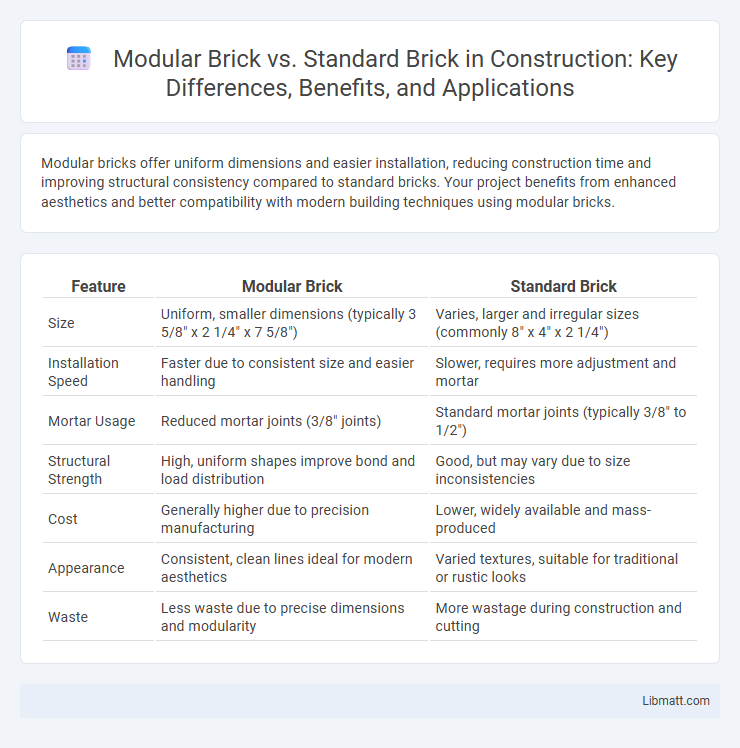Modular bricks offer uniform dimensions and easier installation, reducing construction time and improving structural consistency compared to standard bricks. Your project benefits from enhanced aesthetics and better compatibility with modern building techniques using modular bricks.
Table of Comparison
| Feature | Modular Brick | Standard Brick |
|---|---|---|
| Size | Uniform, smaller dimensions (typically 3 5/8" x 2 1/4" x 7 5/8") | Varies, larger and irregular sizes (commonly 8" x 4" x 2 1/4") |
| Installation Speed | Faster due to consistent size and easier handling | Slower, requires more adjustment and mortar |
| Mortar Usage | Reduced mortar joints (3/8" joints) | Standard mortar joints (typically 3/8" to 1/2") |
| Structural Strength | High, uniform shapes improve bond and load distribution | Good, but may vary due to size inconsistencies |
| Cost | Generally higher due to precision manufacturing | Lower, widely available and mass-produced |
| Appearance | Consistent, clean lines ideal for modern aesthetics | Varied textures, suitable for traditional or rustic looks |
| Waste | Less waste due to precise dimensions and modularity | More wastage during construction and cutting |
Introduction to Modular and Standard Bricks
Modular bricks typically measure 3 5/8 inches in length, allowing for uniform construction and easier installation with mortar joints that standardize wall thickness. Standard bricks, often larger at 8 inches long, offer traditional size variations but may require more mortar and labor to align properly. Your choice between modular and standard bricks impacts project efficiency, structural consistency, and overall aesthetic appeal.
Definition and Specifications of Modular Bricks
Modular bricks are standardized masonry units with dimensions typically measuring 3-5/8 inches in height, 2-1/4 inches in width, and 7-5/8 inches in length, designed to fit a modular system that accommodates mortar joints, resulting in a nominal size of 4 x 2-2/3 x 8 inches. These bricks ensure uniformity and ease of construction, as their precise dimensions allow for consistent courses and alignment with building plans. In contrast, standard bricks vary more in size and are generally larger, lacking strict dimensional control, which can complicate construction and affect the uniformity of the masonry work.
Definition and Specifications of Standard Bricks
Standard bricks, typically measuring 190 mm x 90 mm x 90 mm, serve as the baseline unit for construction with uniform dimensions allowing consistent mortar joints. Made from clay or shale, they exhibit high compressive strength, usually around 10-15 MPa, and are kiln-fired for durability and weather resistance. These bricks are widely used for load-bearing walls, offering reliable thermal insulation and structural integrity in various building projects.
Dimensions and Size Comparison
Modular bricks typically measure 7 5/8 inches long by 3 5/8 inches wide and 2 1/4 inches high, providing a consistent size that allows for thinner mortar joints and more bricks per wall area. Standard bricks, often bigger at 8 inches long by 4 inches wide and 2 1/4 inches high, create thicker joints and slightly less uniform layering. Understanding these dimensional differences helps optimize your brickwork for precision, cost, and aesthetic appeal.
Material Composition and Manufacturing Process
Modular bricks are typically made from a blend of natural clay and shale, fired at lower temperatures to achieve consistent density and uniform size, resulting in improved precision during construction. Standard bricks, on the other hand, often include a broader mix of materials such as clay, sand, and water, with manufacturing processes that may involve higher firing temperatures, leading to variable sizes and densities. Your choice between modular and standard bricks will impact the structural uniformity and aesthetic finish of your building project due to differences in material composition and manufacturing techniques.
Structural Strength and Durability
Modular bricks offer enhanced structural strength due to their uniform size and precise manufacturing standards, allowing for tighter mortar joints and improved load distribution. Standard bricks, while durable, may have slight size variations that can impact the overall stability and longevity of a structure. Choosing modular bricks can optimize your building's resilience and durability in long-term construction projects.
Construction Efficiency and Cost Implications
Modular bricks, with their standardized dimensions, streamline alignment and reduce mortar usage, significantly enhancing construction efficiency compared to standard bricks. The uniform size of modular bricks accelerates labor speed and minimizes material wastage, leading to lower overall project costs. While initial costs for modular bricks may be slightly higher, the savings in labor and consistent quality contribute to substantial long-term cost benefits.
Aesthetic Versatility and Design Flexibility
Modular bricks offer greater aesthetic versatility due to their standardized dimensions and consistent shape, enabling seamless integration into diverse architectural styles and intricate patterns. Their uniformity supports design flexibility by allowing precise alignment and creative configurations such as herringbone or basketweave layouts. In contrast, standard bricks, with varied dimensions and textures, provide a more rustic appearance but limit complex design options and repetitive pattern consistency.
Environmental Impact and Sustainability
Modular bricks significantly reduce environmental impact due to their precise manufacturing process, which minimizes waste and allows for better material efficiency compared to standard bricks. Their smaller size results in lighter transportation loads, decreasing carbon emissions associated with shipping. Choosing modular bricks can enhance Your building's sustainability by supporting eco-friendly construction methods and reducing the overall carbon footprint.
Choosing the Right Brick: Key Considerations
Modular bricks offer a consistent size of 7 5/8 by 2 1/4 by 3 5/8 inches, allowing for faster and more precise construction compared to standard bricks, which typically measure 8 by 3 5/8 by 2 1/4 inches. The uniformity of modular bricks reduces mortar usage and labor costs, enhancing overall project efficiency. Factors such as dimensional consistency, structural requirements, aesthetic preferences, and budget constraints are essential when selecting between modular and standard bricks.
Modular brick vs standard brick Infographic

 libmatt.com
libmatt.com